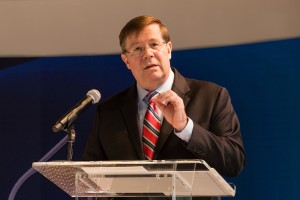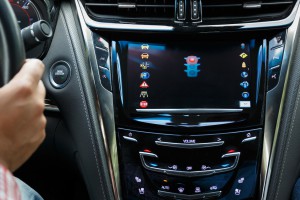
Jim Lentz, CEO of Toyota Motor North America, said the company plans to equip Toyota and Lexus vehicles with V2X tech in 2021.
Though some vehicles already utilize V2X communication, Toyota and Lexus plan to advance the technology further by introducing it into their lineups beginning in 2021 and rolling out across their portfolios by the mid-2020s.
The company announced today that its Dedicated Short-Range Communications (DSRC) systems will use the technology to talk to other vehicles (V2V) and infrastructure (V2I) in hopes of cutting down on collisions, injuries and fatalities.
“By allowing vehicles’ intelligent systems to collaborate more broadly and effectively through DSRC technology, we can help drivers realize a future with zero fatalities from crashes, better traffic flow and less congestion,” said Jim Lentz, CEO of Toyota Motor North America (TMNA), in a statement.
DSRC technology isn’t entirely new and has been tested through government-industry collaborations and is already deployed in some areas of the U.S. It supports the broadcast of precise vehicle information several times per second, including location, speed and acceleration, Toyota notes.
(Toyota, Subaru set to replace sports car. Click Here.)
This information can be used by other DSRC-enabled vehicles and devices to help drivers prevent collisions. Communication can also be enabled to provide helpful real-time information to drivers, such as potential hazards, slow or stopped vehicles ahead, or signals, signs, and road conditions that may be difficult to see.
Given the current climate about shared information, it’s important to note that the information is shared anonymously between vehicles and infrastructure and is not collected by a central entity. DSRC communicates using 7 channels of the 5.9 GHz spectrum band allocated for Intelligent Transportation Systems.
Consumers aren’t charged for the transmission or reception of the information as it doesn’t come across a cellular or data network, and the information is standardized so Toyota and Lexus vehicles can communicate with other similarly equipped vehicles regardless of brand.
The technology is in use in many areas. Audi utilizes it for its Traffic Light Information technology, an Audi connect PRIME feature. The feature, which began use in Las Vegas only in late 2016 was available on select 2017 Audi A4, Q7 & allroad models, and enabled the vehicle to communicate with the infrastructure in select cities and metropolitan areas across the U.S.
The traffic light technology displays the time remaining until the signal changes to green in the driver instrument cluster, allowing the driver to know how much time he or she has to perhaps change the radio station or perform some other task.
(Toyota investing $2.8b to create new company focused on developing self-driving cars. Click Here for the full story.)
Audi isn’t alone, Cadillac began equipping its CTS sedan with similar V2X technologies in 2017. GM is working with the Michigan Department of Transportation and Macomb Country Department of Roads, to develop and implement technology for the connected and automated vehicle environment. An early test was able to tell drivers when a traffic light was going to change color, helping the driver to make a safer decision.
Cadillac’s V2V solution uses GPS for positioning and DSRC for communication, which can handle 1,000 messages per second from vehicles up to about 1,000 feet away. V2V-equipped vehicles create an ad hoc wireless network that allows for the transfer of information without relying on sight lines, good weather conditions or cellular coverage.
The University of Michigan’s Transportation Research Institute is helping to develop V2X technologies in a controlled environment in Ann Arbor, Michigan. Several automakers and suppliers are working in concert to create an entire “ecosystem” of connected vehicles and infrastructure to see how roads can be made safer.
In 2012, UMTRI and the U.S. DOT launched the Safety Pilot Model Deployment (SPMD), a $30 million research project to assess the effectiveness of connected vehicle safety technology at reducing crashes.
The project spanned three years and incorporated more than 2,800 vehicles and 73 lane-miles of instrumented roadway. Building on the success of SPMD, UMTRI and its partners are expanding the existing infrastructure footprint from northeast Ann Arbor to the entire 27-square miles of the City of Ann Arbor.
(To see more about Toyota’s track-bound Supra Concept, Click Here.)
The effort is much like that of Google’s – now Waymo – efforts to test autonomous vehicles Mountain View, California, the city surrounding Google’s campus.

